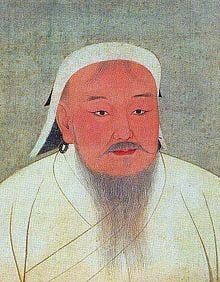Genghis Khan might have been the greenest invader of all time. His bloody conquests killed tens of millions of people. But at the same time, he killed so many people that in the path of his invasion, huge swathes of cultivated land returned to forests, eliminating a huge amount of carbon from the atmosphere.
Genghis Khan, the killer
When some 600 years after your lifetime, people don’t refer to you by your real name, but by a name meaning “Supreme Ruler” (which is what “Genghis Khan” means), you’ve done some things in life.
In just a lifetime, Genghis Khan created the largest empire that ever was — larger than what the Romans did in centuries. As you might guess, he didn’t accomplish this through peaceful negotiation and smooth diplomacy — Genghis Khan was a conqueror by force.
The wars led in his name killed some 40 million people (about 10% of the world’s population at the time)! But, as a new study showed, these bloody conquests helped the environment, removing nearly 700 million tons of carbon from the atmosphere.
While the Mongol ruler wasn’t even thinking about it, he was causing the first man-made global cooling.
‘It’s a common misconception that the human impact on climate began with the large-scale burning of coal and oil in the industrial era,’ said Julia Pongratz, who headed the research by the Carnegie Institution’s Department of Global Ecology.
‘Actually, humans started to influence the environment thousands of years ago by changing the vegetation cover of the Earth’s landscapes when we cleared forests for agriculture,’ she explained.
A bloody legacy
Genghis Khan is one of the greatest conquerors in history — but he accomplished this by committing genocide. He conquered all of modern Mongolia and vast swaths of Siberia within five years. Some of the often-quoted figures are downright outrageous.
Genghis Khan is said to have killed 1,747,000 people in the battle of Nishnapur and 2,400,000 in the battle of Herat, for instance — but some scholars don’t even think those cities had that many people to begin with. Even if they did, it’s unlikely that every last person was killed. Genghis Khan showed little interest in ruling the areas he conquered as long as he obtained the goods and manpower he desired, and he did carry out bloody genocides more than once, but it’s impossible to know exactly how many he killed.
Historical The Persian scholar Juvayni states that 50,000 Mongol soldiers were given the task of executing twenty-four Urgench citizens each, which would mean that 1.2 million people were killed. These numbers are considered logistically implausible by modern scholars, but the sacking of Urgench was no doubt a bloody affair.
Before you get to some very wrong conclusion, this is in no way connected to current climate change, and no one is suggesting fighting climate change through war and conquest – that’s nonsense. What this study does is provide insight into how long events must be to create durable shifts in the planet’s climate.
‘We found that during the short events such as the Black Death and the Ming Dynasty collapse, the forest re-growth wasn’t enough to overcome the emissions from decaying material in the soil,’ explained Pongratz. ‘But during the longer-lasting ones like the Mongol invasion… there was enough time for the forests to re-grow and absorb significant amounts of carbon.’
This is not just about understanding historic events. It also reveals new information about the carbon cycle, and how we are affecting it, potentially yielding valuable information for policymakers. If we know how our actions affect the carbon cycle and climate change, then maybe we can take more responsible action.
‘Based on the knowledge we have gained from the past, we are now in a position to make land-use decisions that will diminish our impact on climate and the carbon cycle,’ she concluded.
Millions of people gone under Mongol rule
Steven R. Ward, a CIA intelligence analyst who specializes in Iran and the Middle East, notes that Mongol violence and depredations in the Iranian Plateau “killed up to three-fourths of the population… possibly 10 to 15 million people. Some historians have estimated that Iran’s population did not again reach its pre-Mongol levels until the mid-20th century.”
Estimates of how many people Genghis Han killed range dramatically, sometimes going up to 100 million. However, the median of these estimates comes to 30-40 million people. This isn’t necessarily the number of people that Genghis Han killed directly, but also people he killed through famine and hunger.
That’s not the only major legacy the Mongolian ruler left behind. According to a different study, millions of people are related to Genghis Han. The bloody legacy of the despot still affects mankind today, in more ways than one.







